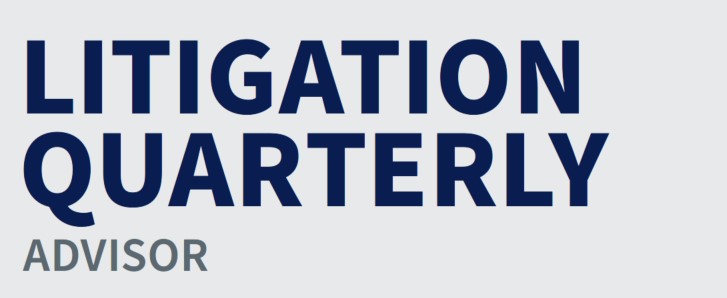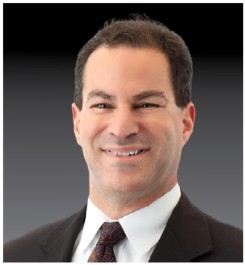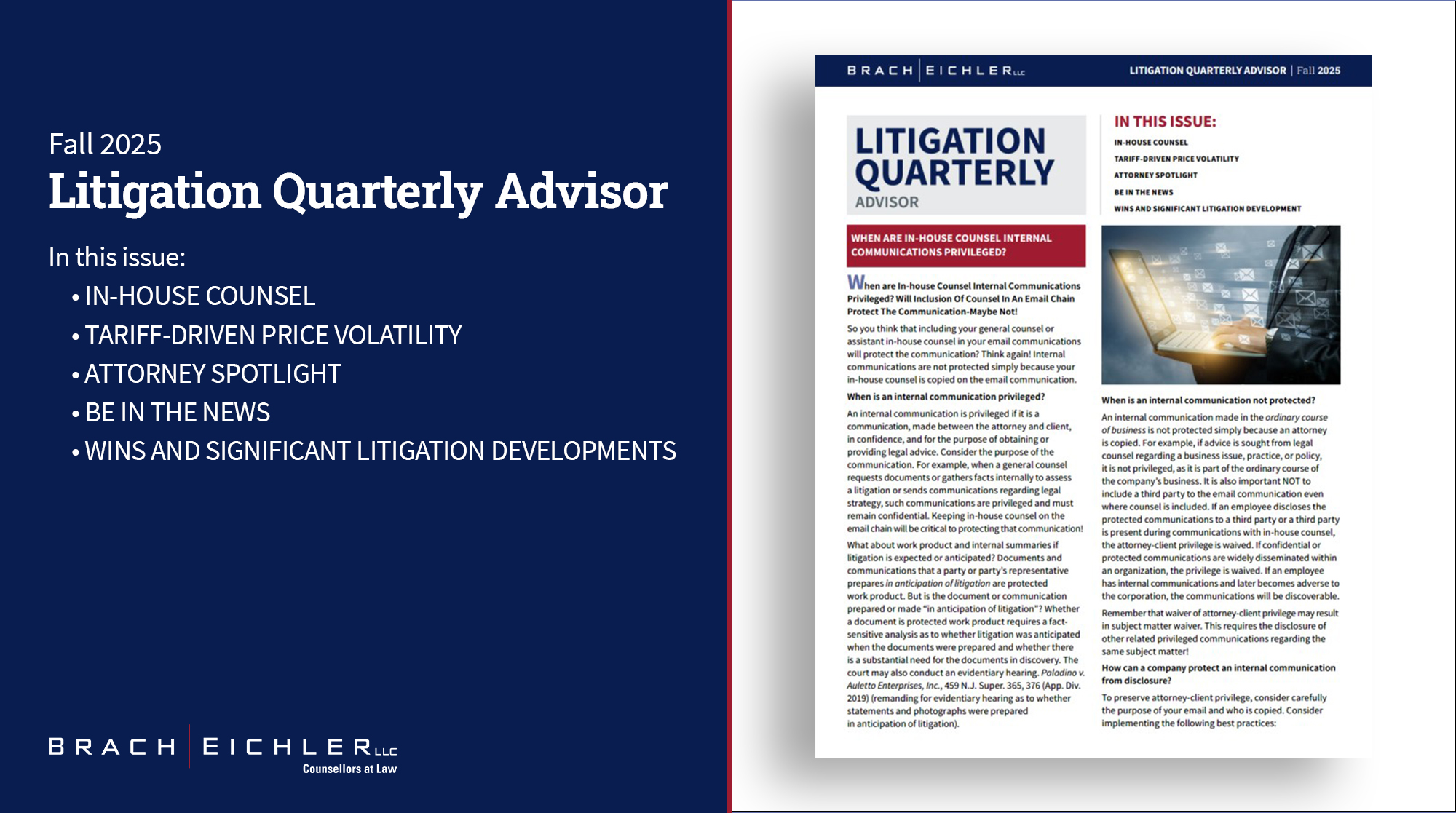

When are In-house Counsel Internal Communications Privileged? Will Inclusion Of Counsel In An Email Chain Protect The Communication-Maybe Not!
So you think that including your general counsel or assistant in-house counsel in your email communications will protect the communication? Maybe Not. Internal communications are not always shielded by privilege simply because your in-house counsel is copied on the email communication.
When is an internal communication privileged?
An internal communication is privileged if it is a communication, made between the attorney and client, in confidence, for the purpose of obtaining or providing legal advice. When evaluating privilege, you must first consider the purpose of the communication. For example, when a general counsel requests documents or gathers facts internally to assess a litigation or sends communications regarding legal strategy, such communications are privileged and must remain confidential. Keeping in-house counsel on the email chain will be critical to protecting that communication. Similarly, when you are seeking legal advice regarding a company practice or policy, or how it may impact an employee, such communications are also subject to privilege.
What about work product and internal summaries if litigation is expected or anticipated? Documents and communications that a party or party’s representative prepares in anticipation of litigation are protected work product. But is the document or communication prepared or made in anticipation of litigation? Whether a document is protected work product requires a fact-sensitive analysis as to whether litigation was anticipated or contemplated when the documents were prepared, whether there is a substantial need for the documents in discovery, and whether the requesting party cannot

obtain the materials through other means without suffering undue hardship. The court may also conduct an evidentiary hearing to address these factors. Paladino v. Auletto Enterprises, Inc., 459 N.J. Super. 365, 376 (App. Div. 2019) (remanding for evidentiary hearing as to whether statements and photographs were work product).
When is an internal communication not protected?
An internal communication made in the ordinary course of business is not protected simply because an attorney is copied. For example, if general counsel is copied on an internal discussion regarding an operational or financial issue that does not require legal analysis, or does not seek legal advice, it may not be privileged. It is also important not to include a third party to the email communication even where counsel is included. If an employee discloses the protected communications to a third party or a third party is present during communications with in-house counsel, there is a risk that the attorney-client privilege may be waived. If confidential or protected communications are widely disseminated within an organization, the privilege may be waived as well. If an employee has internal communications and later becomes adverse to the corporation, the communications could be discoverable.
Remember that waiver of attorney-client privilege may result in subject matter waiver. This requires the disclosure of other related privileged communications regarding the same subject matter.
How can a company protect an internal communication from disclosure?
To preserve attorney-client privilege, consider carefully the purpose of your email and who is copied. Consider implementing the following best practices:
• DO NOT “reply all” without knowing who is on the email chain and review the entire email chain;
• DO limit the distribution of privileged materials/communications to individuals who are necessary to advance the legal purpose of the communication;
• DO use privilege designations on emails, such as attorney-client privileged communication in the subject line; and
• DO NOT forward legal advice.
Limiting privileged communications, avoiding the widespread dissemination of confidential or protected information, and carefully considering the content of emails are all part of a company’s best practices for limiting the disclosure of privileged communications and documents and to prevent the waiver of attorney-client privilege, particularly in cases where litigation is pending or anticipated.
If you have any questions about this alert, please contact:
Rose Suriano, Esq., Member | 973.403.3129 | rsuriano@bracheichler.com
Robyn K. Lym, Esq., Associate | 973.403.3124 | rlym@bracheichler.com

In the first half of 2025, the U.S. economy was significantly influenced by escalating trade tensions and the implementation of new tariffs. The continuously fluctuating landscape of U.S. tariffs—particularly on materials such as Canadian steel and lumber—has introduced an added layer of uncertainty for many industries, including the
construction industry, whether as an owner, general contractor, or subcontractor. Tariffs fall under external economic factors, but increasingly play a large role in determining the price of goods and services when entering into a contract or preparing a bid or proposal.
Very few businesses can absorb the unexpected costs of tariffs. Tariffs can also contribute to material delays in the supply chain and in project schedules, which often translate into claims of breach and tangible losses such as delay damages and indemnification risks. These disruptions are felt across the spectrum, but skillful negotiation and forward-looking contract drafting can apportion the economic pain of unexpected tariffs, or at least grant flexibility on how to mitigate your risks.
One way to alleviate tariff risks is an escalation clause. An escalation clause is a provision that allows a party to a contract to obtain payment for unforeseen increased costs, and in the construction context a contractor or subcontractor can submit a change order, in the event of a significant change in price or procurement of materials due to external unforeseen factors. For example, a simple escalation clause may look like the following:
Several important considerations should be taken into account. The example above utilized a percentage-based trigger, but in certain situations, such as contracts exceeding $10 million, where each percentage point may represent a hundred thousand dollars in potential exposure, it may be more appropriate to utilize a specific dollar-value threshold instead.
Alternatively, an index-based cost adjustment threshold may be more appropriate and provide more clarity on how the risk of price increases is allocated. An index-based cost adjustment uses a predefined index or formula to adjust the cost of a project based on the changes in the market prices of certain items. The U.S. Bureau of Labor Statistics issues a Consumer Price Index (CPI) that reflects the fluctuations in the market. It is calculated as the
weighted average price of a market basket of consumer goods and services. Index based cost adjustments are viewed as standardized and neutral.
It is also essential to include clear notification and documentation requirements. The receiving party of a request for an escalation increase is generally disinclined to rely solely on an assertion that material prices have increased. Supporting documentation, such as updated quotes or supplier proposals, to substantiate the claimed cost increases are critical. If the escalation clause involves a CPI, a copy of the relevant CPI should also be attached to the request for an increase or Change Order.
Contracts without escalation clauses may carry significant financial risk. The decision to accept a bid or proposal with or without an escalation clause ultimately depends on the appetite for controlling risk.
If you have any questions about this alert, please contact:
Doris Cheung, Counsel | 973.403.8309 | dcheung@bracheichler.com
You’ve invested heavily in your property. The work is done, the space looks sharp—and then a subcontractor you never hired files a lien against your building. What just happened?
Welcome to the world of construction liens, an area of New Jersey law that surprises owners and safeguards contractors. The New Jersey Construction Lien Law (N.J.S.A. 2A:44A-1 et seq.) governs this terrain. And while it may not make for light beach reading, it’s essential knowledge for anyone improving or owning real estate.
The law serves two purposes:
(1) to secure payment for contractors, subcontractors, and suppliers who add value to a property; and
(2) to impose structure so that owners don’t end up paying multiple times for the same work.
Signed Means Signed
To be valid, a lien claim must be based on a signed written contract. No oral agreements, no unsigned change orders—even if everyone agreed verbally. If you’re a contractor and you want to include additional work in your lien, get it signed.
Time Is Tight
Deadlines matter. For commercial projects, a lien must be filed within 90 days of the last day of contract work.
Minor repairs or punch list items won’t extend the clock. For residential jobs, the process is more complex: a Notice of Unpaid Balance and Demand for Arbitration must be filed within 60 days, with any lien recorded within 120 days after last work.
Where to File
Construction liens are not filed with the courts. They’re recorded with the County Clerk where the property is located. And if the lienor doesn’t file a foreclosure action within one year of last work, the lien becomes unenforceable.
The Lien Fund
If multiple lien claims are filed on the same project, New Jersey law limits the owner’s exposure through the lien fund concept. It caps the total liability to the amount actually owed under the contract for work completed, regardless of how many claims are made.
Get It Right—Or Else
A flawed lien can lead to penalties. If a claim is willfully overstated, or if a defense is frivolous, the responsible party may face attorneys’ fees, interest, and damages. The lien form may look simple, but the risks are real.
Bottom Line
Whether you’re an owner, contractor, or supplier, construction liens are more than just paperwork—they’re legal instruments that can dramatically shift leverage. Filing one (or facing one) without understanding the rules is a gamble.
If you’re planning work—or already deep into it—talk to counsel early. You’ll save time, avoid disputes, and protect your bottom line.
If you have any questions about this alert, please contact:
Edward Altabet, Member | 973.447.9671 | ealtabet@bracheichler.com
Andrew R. Macklin, Member | 973.447.9670 | amacklin@bracheichler.com


The phase “defend, indemnify, and hold harmless” is found in many, if not most, contracts with liability allocation provisions, across multiple industries. However, many parties do not have a complete understanding of what, exactly, these words mean. The meaning of all three terms varies on a state-by-state basis. Some states require an indemnitor to defend an indemnitee. Some states view the duties to defend and indemnify as wholly separate. Understanding the meaning of this common phrase goes a long way toward ensuring that the parties’ risk allocation choices (and, ultimately, their economic deal) are respected, which is important in the best of times, and vital in the worst.
Indemnification
The concept of indemnification imposes an obligation on one party, the indemnitor, to pay or reimburse another party, the indemnitee, for losses covered in the indemnification provision. The obligation to reimburse or pay arises when an actual loss or liability has occurred. Generally, indemnification arises in two ways: through an express contractual provision or implied in the law. When contained in a contract, the courts will honor its plain meaning and the intent of the parties. Generally, if there happens to be any ambiguity surrounding an indemnity clause, including what it means or its scope, it is typically construed by courts against whomever is seeking indemnification.
As to indemnity implied by operation of law, many states including New Jersey, hold that, absent anything to the contrary in a contract, a person is entitled to an implied indemnity when the implied indemnitor is not at fault and still incurs liability due to the wrongful conduct of another. See Cartel Cap. Corp. v. Fireco of New Jersey, 81 N.J. 548, 566 (1980). In Alten v. Ellin & Tucker, Chartered, 854 F. Supp. 283, 288-89 (D. Del 1994), the District Court for the
District of Delaware also noted that without an express contractual indemnification provision, a party may still rely on implied indemnity where appropriate, such as where there is a contractual relationship between the parties. Importantly, the party seeking to rely on implied indemnity to recover cannot be at fault.
Defend
The duty to defend triggers an obligation to act when a claim, which is covered by the indemnification provision in the contract, is brought by a party against the indemnitee. Polarome Int’l, Inc. v. Greenwich Ins., 404 N.J. Super. 241, 272 (App. Div. 2008). The independent obligation to defend requires the indemnitor to actually defend, finance a defense, or reimburse the indemnitee against any claim brought against it, regardless of the merits of the claim or the outcome. The differences between the duty to indemnify and to defend, while nuanced, are critically important. The obligation to indemnify arises once a judgment has been entered, whereas the obligation to defend is triggered as soon as a claim is filed against the indemnitee.
Most states, including New Jersey, consider the duty to indemnify and to defend to be distinct obligations.
Hold Harmless
The inherent meaning of “hold harmless” is subject to interpretation. The prevailing interpretation is that “hold harmless” and “indemnify” are synonymous. However, under the minority view, “hold harmless” requires payment of both actual losses and potential liabilities, while “indemnify” protects against incurred losses only. The main difference is that “hold harmless” may require a party to protect against actual losses as well as potential losses while indemnification protects against actual losses only.
In New Jersey courts have generally interpreted the obligations to “hold harmless” and “indemnify” as synonymous. See, e.g., Miller v. Hall Bldg. Corp., 210 N.J. Super. 248, 320 (Law. Div. 1985).
Similarly, certain other states, including Ohio, Colorado, Louisiana and Delaware, hold that “indemnify” and “hold harmless” are synonymous. Alternatively, California sees the two concepts as distinct as shown in Queen Villas Homeowners Assn v. TCB Prop. Mgmt., 149 Cal. App. 4th 1, 9 (Dist. Ct. App. 2007). There, the court categorized the obligations to indemnify and hold harmless as offensive
and defensive rights. Indemnification, according to the court, is “an offensive right—a sword—allowing the indemnitee to seek indemnification.” Id. On the other hand, hold harmless is a defensive measure providing “[t]he right not to be bothered by the other party itself
seeking indemnification.” Id. Under this view, hold harmless shields one party from being sued for liability that the other party may incur.
Concerns in the Current Market
Current market conditions have emphasized the importance of ensuring that risk allocations are understood. Whether the obligations that arise under the contractual terms “defend, indemnify and hold harmless” offer meaningful protection, when a party defaults or does not have the financial ability to honor them, creates risk that must be considered at the time of contract. Whether the provisions hold up through bankruptcy and dissolution are also concerns. It is important to realize that the duty to indemnify may not survive bankruptcy as demonstrated recently in Texas. The U.S. Bankruptcy Court for the Northern District of Texas, in In re Superior Air Parts, Inc., 486 B.R. 728, 740 (N.D. Tex. 2012) held that contractual indemnity provisions give rise to a dischargeable claim. In New Jersey, courts consider the nature of the indemnification obligation to determine whether the debt is dischargeable in bankruptcy proceedings. See, e.g., Winegarden v. Winegarden, 316 N.J. Super. 52, 61 (App. Div. 1998).
How can parties in a contract protect their indemnification claims? One option is to insure against the claims. Representation and Warranty Insurance, Director and Officer Insurance and contingent liability policies have becoming increasingly common vehicles that can provide a financial backstop for risk allocation choices. Being knowledgeable about how defend, indemnify and hold harmless provisions are interpreted and applied is crucial in today’s market. A lack of clear understanding about how an indemnification clause will operate may have long lasting and a significant impact. Consider these benefits and risks when drafting your next agreement.
If you have any questions about this alert, please contact:
Rose Suriano, Member | 973.403.3129 | rsuriano@bracheichler.com
Robyn Lym, Associate | 973.403.3124 | rlym@bracheichler.com
In Little v. American Income Home Life Ins. Co., 2025 WL 1550016, the Appellate Division of New Jersey’s Superior Court recently struck an arbitration provision appearing in General Agent agreements. The employer was a
New Jersey-based general agent of a Texas life insurance company. The plaintiffs commenced actions in New Jersey courts alleging violation of their rights under New Jersey’s Law Against Discrimination (“LAD”). The agreements stated the enforceability of the arbitration agreement shall be governed by the Federal Arbitration Act (“FAA”); all other issues shall be decided and governed by Texas law.

The Appellate Division held that although the FAA favors arbitration, under the FAA, agreements to arbitrate are subject to invalidation by applicable generally applicable contract defenses. After undertaking a detailed analysis of choice-of-law rules (New Jersey vs. Texas), the panel determined that New Jersey law controls the “validity and enforceability” of the parties’ agreements to arbitrate. Under New Jersey’s seminal decision, Atalese v. U.S. Legal Services Gp., 219 N.J. 430 (2014), waiver-of-rights provisions, such as in employment agreements, will be enforceable only if they clearly and unambiguously state that a party’s right to a trial, including before a jury, is being waived. As a result, the plaintiffs are permitted to seek redress for their claims in court, as opposed to in arbitration. That is, the Court found the arbitration provision of the plaintiffs’ agreements with defendants not enforceable.
The Little opinion is the latest judicial decision sending a message to New Jersey employers that if they wish to have enforceable arbitration agreements, the agreements must be clear, direct and express as to a jury trial waiver. It is for this reason that employers need to consult with knowledgeable counsel to both assess the need for a trial waiver in favor of mandatory, binding arbitration and whether to include an enforceable jury trial waiver (i.e., a mandatory arbitration provision) in an employment contract.
For more information, please contact:
Matthew M. Collins | 973.403.3151 | mcollins@bracheichler.com
Ashley L. Matias | 973.364.8330 | amatias@bracheichler.com

While New Jersey state courts have generally permitted an award of prevailing party attorney fees when only a preliminary injunction is obtained in 42 U.S.C. § 1983 cases, the ability to obtain the same relief in Third Circuit courts going forward may hinge on their interpretation and application of the United States Supreme Court’s decision in Lackey v. Stinnie, 145 S. Ct. 659, 667 (2025), which does not permit such relief. Specifically, on February 25, 2025, the United States Supreme Court held that a plaintiff in civil rights type case who brings a claim under 42 U.S.C. § 1983 and obtains a preliminary injunction is not considered a prevailing party and is not entitled to an award of attorney’s fees. The Court’s decision is particularly notable because the law being challenged was repealed by the Virginia General Assembly following the issuance of a preliminary injunction, thereby mooting the need for a permanent injunction. Even so, in denying an award of prevailing party fees, the United States Supreme Court concluded that “[b]ecause preliminary injunctions do not conclusively resolve the rights of parties on the merits, they do not confer prevailing party status.” Lackey v. Stinnie, 145 S. Ct. 659, 667 (2025). This decision represents an effort by the Supreme Court to develop a bright line test for the relief necessary to warrant an award of prevailing party fees in civil rights cases. Thus far, federal courts in various circuits have applied the Lackey decision, including Courts in the United States Court of Appeals for the Third Circuit.
Specifically, on May 9, 2025, in Augustyn v. Wall Township Board of Education, the United States Court of Appeals
analyzed the Lackey decision in a case where the plaintiff won procedural relief at the outset of the case, but was ultimately unsuccessful. In doing so, the Court ultimately held that plaintiff was a prevailing party under the Individuals with Disabilities Education Act due to a procedural victory at summary judgment, irrespective of the plaintiff’s lack of success during later proceedings before an Administrative Law Judge. Augustyn v. Wall Township Board of Education, 139 F. 4th 252, 258-59 (3rd Cir. 2005). And while Augustyn did not involve the issuance of a preliminary injunction, the Third Circuit’s analysis of Lackey could provide a preview for how other federal courts in the Third Circuit will apply the United States Supreme Court’s bright-line test. For example, the Augustyn Court used language in the Lackey decision to analyze the concept of transient relief as compared to relief that constituted an enduring or permanent change at any point in the case, and ultimately concluded that a change in the legal relationship between the parties and permanent procedural relief at an earlier state of the proceeding would confer prevailing party status. By distinguishing Lackey and emphasizing circumstances where procedural relief could constitute lasting relief, the Court’s comments in the Augustyn may guide other courts in the Third Circuit going forward. So far, the District of New Jersey has addressed the Lackey decision in three instances, but none have addressed the entitlement to attorney fees when the only relief awarded is a preliminary injunction.
And while it is anticipated that state courts, will also begin to apply the Lackey decision, prior to Lackey, New Jersey courts have allowed for an award of prevailing party attorney fees when a preliminary injunction is obtained in 42 U.S.C. § 1983 cases. For example, in Empower Our Neighborhoods v. Guadagno, New Jersey’s Appellate Division affirmed the trial court’s determination that obtaining a preliminary injunction in a § 1983 case rendered the plaintiff a prevailing party, even though the plaintiff did not ultimately prevail on every issue in the case. Empower Our Neighborhoods v. Guadagno, 453 N.J. Super. 565 (App. Div. Mar. 8, 2018). Going forward, as the courts begin to apply the Lackey decision, an assessment of the whether to bring a civil rights claim in either federal or state court may become important for evaluating the likelihood of prevailing party fees and attorneys at Brach Eichler can assist in analyzing this issue.
If you have any questions about this alert, please contact:
Lauren Woods, Counsel | 973.364.5211 | lwoods@bracheichler.com
Get to know the faces and stories of the people behind the articles in each issue. This month, we invite you to meet Member Stuart Polkowitz and Counsel Doris Cheung.
 STUART J. POLKOWITZ
STUART J. POLKOWITZ
Stuart Polkowitz handles matters encompassing all phases of litigation and arbitration. In particular, he focuses on general business litigation, real estate litigation, complex construction litigation, and insurance coverage. He also counsels insurance companies on run off operations and strategies. Additionally, Stuart handles issues involving regulatory matters and unclaimed property audits. Stuart also serves as outside counsel to group dental practices and dental support organizations, handling a broad scope of contract relations, employment, regulatory, real estate, and corporate matters. He is also experienced in counseling and defending clients on insurance coverage matters and contractual relationships and bad faith claims against insurance companies.
When not in the office, Stuart enjoys spending time with his grandson, at the gym and rooting for (or being frustrated by) the Yankees. Stuart’s hobbies include collecting and drinking California wines and taking walks along the Jersey Shore’s beaches and boardwalks.
 DORIS CHEUNG
DORIS CHEUNG
Doris Cheung is Counsel in the firm’s Litigation practice. Her practice focuses on complex commercial litigation in both state and federal courts and arbitration and mediation. She has experience with complex civil litigation, contract disputes, insurance and healthcare matters, shareholder disputes, employment disputes, and other commercial claims. On the weekends, Doris looks forward to playing beach volleyball with her friends, spending time with her rambunctious seven year old daughter, and indulging in her undiagnosed obsessive compulsive disorder to clean the house. Her guilty pleasure is watching Korean dramas—the more fantastical the better.

Brach Eichler LLC is pleased to announce that thirty four lawyers have been included in the 2026 edition of The Best Lawyers in America®. Additionally, twenty three Brach Eichler attorneys have been selected to the publication’s “Ones to Watch” category, recognizing up-and-coming young lawyers. Congratulations to Lindsay P. Cambron, Edward P. Capozzi, Shannon Carroll, Judge Lisa Chrystal, Matthew M. Collins, Riza I. Dagli, Jonathan S. Davis, Lani M. Dornfeld, Susan Dromsky-Reed, John D. Fanburg, Stuart M. Gladstone, Charles X. Gormally, Joseph M. Gorrell, Carol Grelecki, Alois V. Habjan, Alan R. Hammer, Edward Hilzenrath, Jeffrey H. Itzkowitz, Thomas Kamvosoulis, Brian R. Lenker, Tracy E. Miller, Stuart L. Pachman, Caroline J. Patterson, Allen J. Popowitz, Kenneth A. Porro, Anthony M. Rainone, Cheryl Ritter, David J. Ritter, David Ritter, Jr., Sean Alden Smith, Carl J. Soranno, Frances B. Stella, Rose A. Suriano, and Edward J. Yun.
The 23 attorneys from the firm included in the “2025 New Jersey Rising Stars” list by Best Lawyers® are: Eric Boden, Brian Brown, Alex S. Capozzi, Jessica Cascio, Doris Cheung, Vanessa Coleman, Mark E. Critchley, Paul DeMartino, Jr., Corey A. Dietz, Rebecca Falk, Jeremy L. Hylton, Daniel G. Leone, Cynthia J. Liba, Robyn K. Lym, Ashley Matias, Daniel Plaia, Daniel J. Plaia, Jalen D. Porter, Neha C. Rao, Michael D. Russo, IV, John Simeone, Michael A. Spizzuco, Jr., Amy Van Fossen and John Zepka.
On July 21, Litigation Chair Keith J. Roberts was recognized by NJBIZ on its prestigious 2025 “Law Power 50” list Compiled by the NJBIZ editorial staff, the Law Power List honors legal professionals who have distinguished themselves through outstanding professional achievements and meaningful public service. Honorees are selected based on editorial research, industry input, and reader recommendations, and are recognized for helping make New Jersey a better place to live, work, and do business.
On July 10, Brach Eichler was named to NJBIZ’s 2025 “Best Places to Work” list.
On June 25, Litigation Member Rose Suriano, along with Associate Robyn K. Lym, issued an alert entitled “When Are In-house Counsel Internal Communications Privileged? Will Inclusion Of Counsel In An Email Chain Protect the Communication – Maybe Not!”
On May 1, Brach Eichler announced the firm’s 2025 promotions. Autumn McCourt was promoted to Member. Autumn is a key member of the firm’s Litigation and Labor & Employment Practices. Additionally, Eric Boden and Jeremy Hylton were promoted to Counsel. Congratulations to Autumn, Eric, and Jeremy
WINS AND SIGNIFICANT BRACH EICHLER LITIGATION DEVELOPMENTS

Attorney Advertising: This publication is designed to provide Brach Eichler LLC clients and
contacts with information they can use to more effectively manage their businesses. The contents
of this publication are for informational purposes only. Neither this publication nor the lawyers who
authored it are rendering legal or other professional advice or opinions on specific facts or matters.
Brach Eichler LLC assumes no liability in connection with the use of this publication.

Stan Barrett | 973.364.5210 | sbarrettl@bracheichler.com
Shannon Carroll | 973.403.3126 | scarroll@bracheichler.com
Matthew M. Collins | 973.403.3151 | mcollins@bracheichler.com
Riza I. Dagli | 973.403.3103 | rdagli@bracheichler.com
Charles X. Gormally | 973.403.3111 | cgormally@bracheichler.com
Anthony M. Juliano | 973.403.3154 | ajuliano@bracheichler.com
Thomas Kamvosoulis | 973.403.3130 | tkamvosoulis@bracheichler.com
Bob Kasolas | 973.403.3139 | bkasolas@bracheichler.com
Andrew R. Macklin | 973.447.9670 | amacklin@bracheichler.com
Autumn M. McCourt | 973.403.3104 | amccourt@bracheichler.com
Stuart J. Polkowitz | 973.403.3152 | spolkowitz@bracheichler.com
Anthony M. Rainone | 973.364.8372 | arainone@bracheichler.com
Richard B. Robins | 973.447.9663 | rrobins@bracheichler.com
Sean Alden Smith | 973.364.5216 | ssmith@bracheichler.com
Carl J. Soranno | 973.403.3127 | csoranno@bracheichler.com
Michael A. Spizzuco, Jr. | 973.364.8342 | mspizzuco@bracheichler.com
Frances B. Stella | 973.403.3149 | fstella@bracheichler.com
Rose Suriano | 973.403.3129 | rsuriano@bracheichler.com
Lindsay P. Cambron | 973.364.5232 | lcambron@bracheichler.com
Doris Cheung | 973.364.8309 | dcheung@bracheichler.com
Hon. Lisa F. Chrystal, P.J.F.P.(Ret.) | 973.364.8359 | lchrystal@bracheichler.com
Mark E. Critchley | 973.364.8339 | mcritchley@bracheichler.com
Edward Ellersick | 973.364.5205 | eellersick@bracheichler.com
Michael A. Rienzi | 973.364.5226 | mrienzi@bracheichler.com
Thomas J. Spies | 973.364.5235 | tspies@bracheichler.com
Lauren Adornetto Woods | 973.364.5211 | lwoods@bracheichler.com
Robyn K. Lym | 973.403.3124 | rlym@bracheichler.com
Katelyn A. Marquez | 973.403.3153 | kmarquez@bracheichler.com
Ashley Matias | 973.364.8330 | amatias@bracheichler.com
Cara Joy Skelley | 973.403.3132 | cskelley@bracheichler.com
Neha C. Rao | 973.447.9668 | nrao@bracheichler.com
John Simeone | 973.447.9665 | jsimeone@bracheichler.com
Roseland, NJ | New York, NY | West Palm Beach, FL | www.bracheichler.com | 973.228.5700



